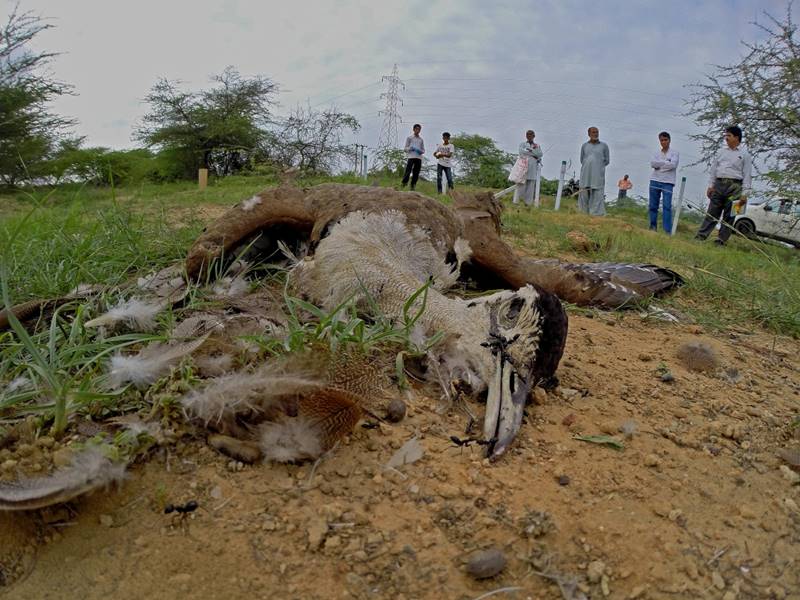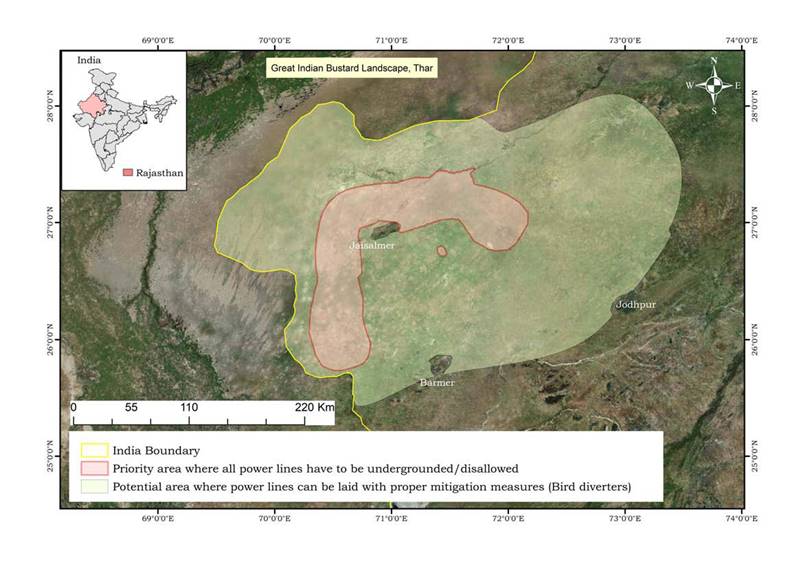‘Overhead power lines being laid despite SC order to protect critically endangered great Indian bustard’
Two conservation groups have pointed out that despite the Supreme Court order of April 19, 2021 ordering measures to be taken to ensure the conservation of the critically endangered Great Indian bustard, violations are being made by renewable energy projects. More details here.


In an affidavit submitted to the Supreme Court, the Union Ministry of Power had admitted that the bird lacks frontal vision. Due to this, they cannot detect power lines ahead of them, from a far off distance.
Despite the Supreme Court of India’s order on the conservation of the critically endangered Great Indian bustard — a large indigenous bird whose population has reduced to 100 in the country — two environment protection groups have stated that the order is not being respected on the ground.
In a joint press statement released on June 19, the Mumbai-based Bombay Natural History Society and The Corbett Foundation stated that despite the apex court asking the underground laying of the powerlines in the natural habitat of the critically endangered bird, the overhead power lines are being set up.

Also Read: Six months later, and after a journey of close to 10,000 kms, Vadla, the common crane, is back
The apex court, on April 19, had passed an order that demanded the concerned authorities to ensure that power lines are laid underground in the habitat of the critically endangered birds. Also, it ordered the installation of bird diverters in the already existing overhead power lines.
“Large renewable energy projects across GIB (Great Indian bustard) habitats, mainly in Rajasthan and Gujarat, have put these already threatened species at the grave risk of extinction,” the press release stated.
Kedar Gore, director of Mumbai-based The Corbett Foundation said: “Despite the SC order, the work on laying of overhead power lines is continuing in Rajasthan and Gujarat without complying to the conditions laid down by the Supreme Court.”

Also Read: The vulture soars again
“None of the existing power lines has been fitted with bird diverters. This disobedience amounts to contempt of court,” he added.
The Wildlife Institute of India (WII) estimates that 18 of these birds die each year due to collision with power lines, making power lines the most significant current threat to these last remaining Great Indian bustards.
Also Read: COVID-19 delays India’s captive-reared vulture release programme
In an affidavit submitted to the Supreme Court, the Union Ministry of Power had admitted that the bird lacks frontal vision. Due to this, they cannot detect power lines ahead of them, from a far off distance.
As they are heavy birds, they are unable to manoeuvre across power lines within close distances. Thus, they are vulnerable to collision with power lines, the Ministry had stated.

“In case of low voltage lines, electrocution is often the cause of death due to smaller phase to phase separation distance. High voltage lines do not cause death due to electrocution but cause death due to collision,” it added.
Meanwhile, in the recent press statement, Bivash Pandav, Director, Bombay Natural History Society (BNHS) termed the Thar desert as the ‘one and only Intensive Critical Care Unit’ of Great Indian Bustard.

“One of the most charismatic bird species of India, the Great Indian Bustard, is undoubtedly standing at the doorstep of extinction… BNHS applauds the judgement of Hon. Supreme Court of India and firmly believes in leaving no stone unturned in safeguarding the remaining Bustard habitats in the Thar desert,” he stated.

